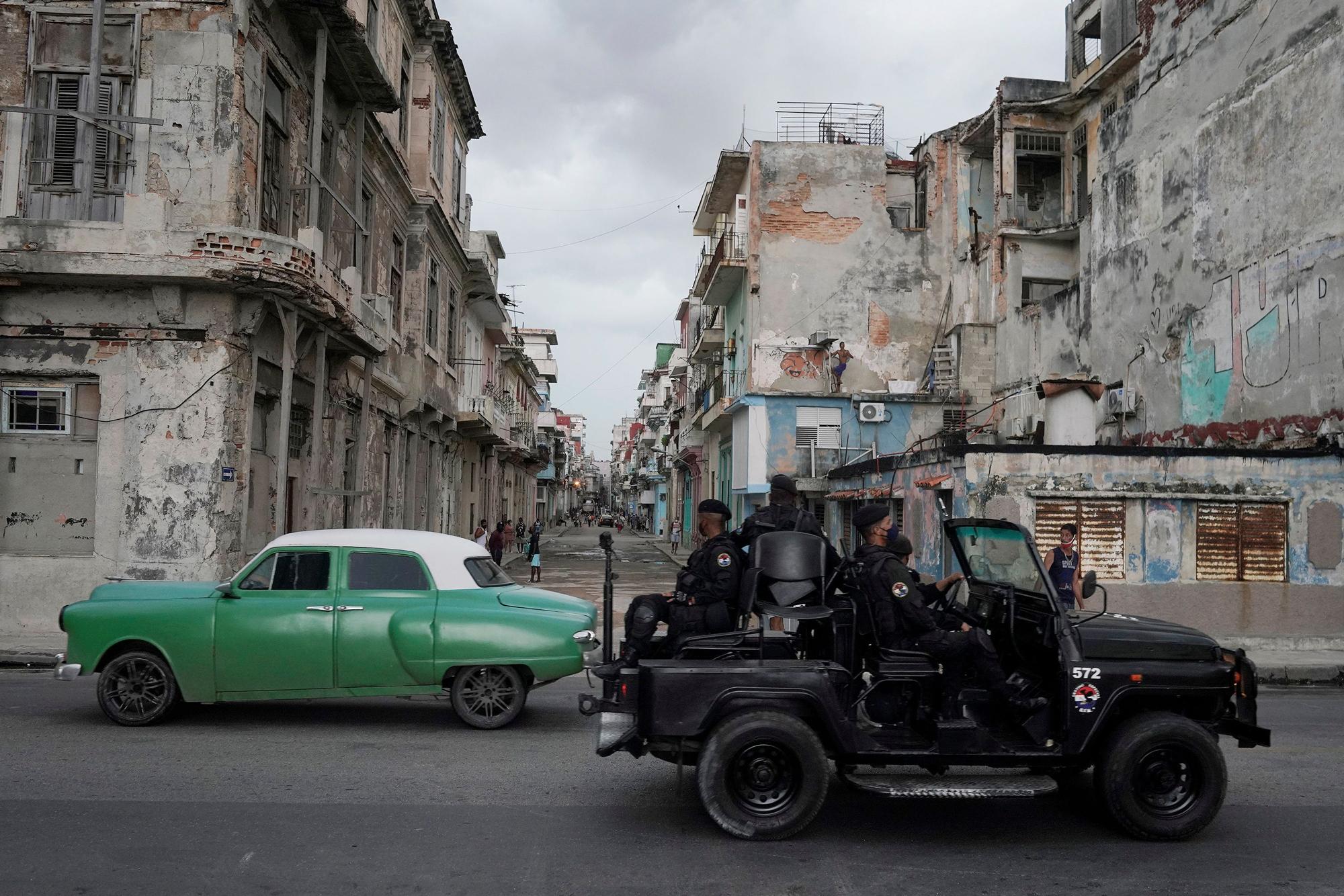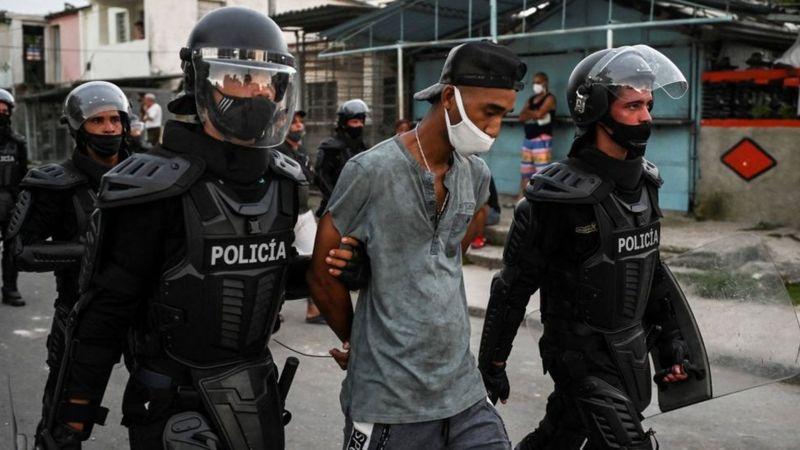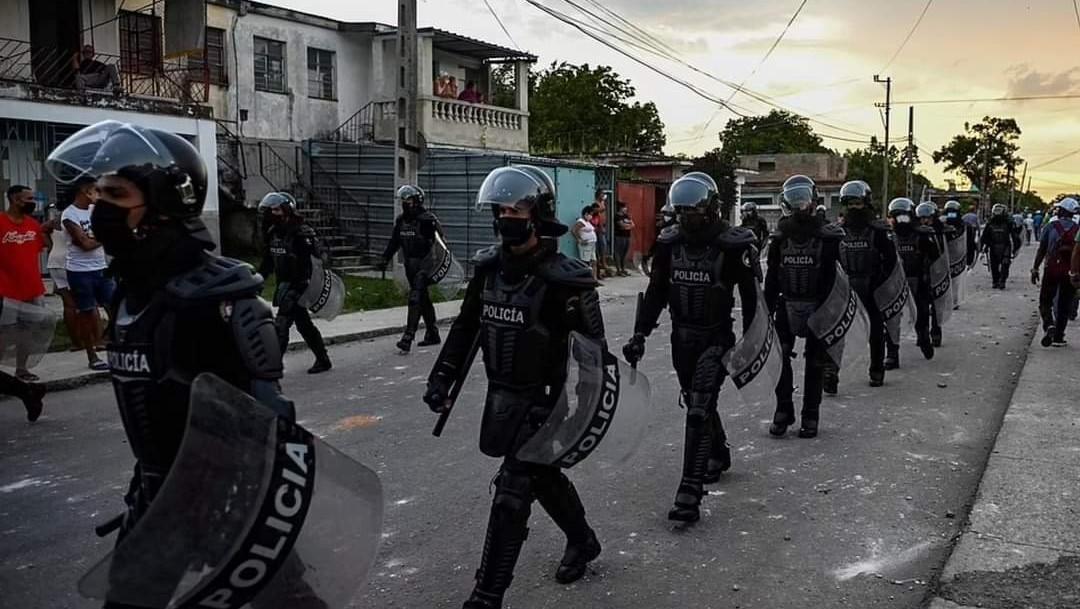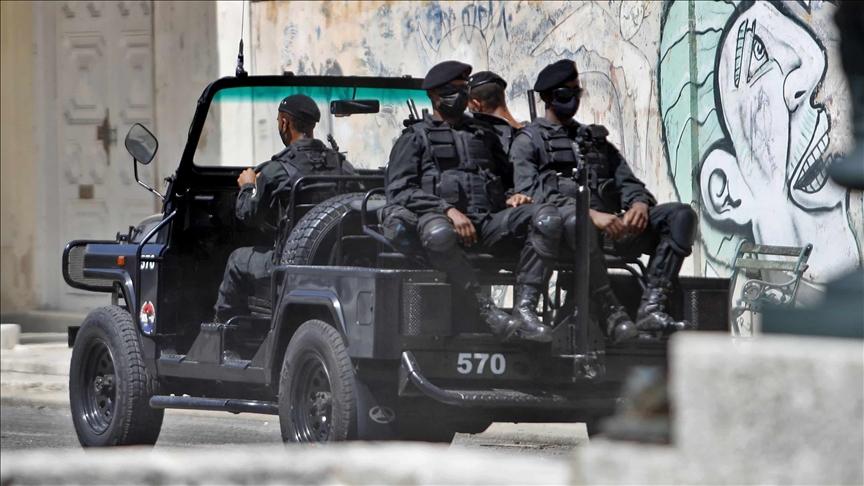-Interview with comrade Gustavo Rodríguez (First of three parts)
These days we have received a torrent of statements generated in the mass disinformation media about the recent protests in Cuba. On the one hand, there are those formulated by the Cuban officialdom and the leftists of the world in the name of anti-imperialism and in defense of what they still call the «Cuban revolution», on the other hand, there are the traditional right-wing media that accuse the «communist dictatorship» of the lack of freedoms and rights.
The Cuban Communist Party and its international acolytes call for solidarity with the regime, arguing that they are facing a new intervention of «Yankee imperialism» which is taking advantage of the disastrous economic conditions caused by more than sixty years of blockade and the greatest health crisis in its history. While the supporters of the free market and the right-wing forces claim that what is happening in the country is the result of its citizens’ oppression due to the lack of opportunities in the socialist regimes.
In these times of post-truth we are suspicious of all these positions, but also, as anarchists, we are not only suspicious of these channels of manipulation but we identify positions that are contrary to our praxis and enemies of our desire for total liberation.
Unfortunately, the information we have received so far with a clear anarchist position from the territory controlled by the Cuban state is minimal. That is why we chose to interview an anarchist voice with whom we identify and asked him to share with us his perspective of the facts from his experience as an exile of Cuban origin, in order to better understand what is happening in Cuba.
From AnarquíaInfo (AI) we have always given place to the reflections of our comrade Gustavo Rodríguez (GR), hosting in our blog almost all his contributions to the informal anarchist tendency and to the development of contemporary insurrectional anarchism, reaffirming the black path of Anarchy and promoting permanent insurrection through an international conspiracy that concretizes the Black International in our days.
AI: Comrade, for us it is a pleasure that you have agreed to this conversation. For some time we had been contemplating doing an interview with you but more focused on issues related to the perspective of the informal and insurrectional anarchist tendency, and your emphasis on «the need to abandon all that is alien». This concern became even greater after reading your last contribution (Against The Tide), where you state that we anarchists «really are «sectarian», «purist», «intransigent» and even «totalitarian».» However, with the passing of time, the revolts in Cuba arose and this made us reformulate this interview, but leaving pending for a future occasion the approach of these crucial issues for the development of a new anarchist paradigm. And well, on this particular occasion, we would like you to comment on your impressions about what is happening in Cuba, with the intention of clarifying things and forming a criterion more in line with our praxis. With this interest in mind, we have formulated the following questions:
AI: What is happening in Cuba?
GR: Comrades, the immense pleasure is mine. First of all, I would like to thank you -for a long time now- for promptly hosting and disseminating my contributions on your website. I also thank you for the opportunity to expose my views on the Cuban situation; however, I declare myself incompetent to answer your first question in all the extension it demands. However, this plea does not arise from the impossibility of being present in the country and/or not having participated in this struggle -there are those who even being there have been unable to take the pulse of the insurrectional moment they are living- but by the vast diversity of perspectives generated by these events from many different points of view, including the different lenses that, in one way or another, claim to be libertarianism and insular anarchism.
Undoubtedly, I can transmit you a balance of the facts through the related reflection of comrades in situ and I will also share with you my perspective from my experience as an exile of that singular banana national socialism1 that for more than six decades reigns with blood and fire in the largest of the Antilles. In that sense, I can assert that last July 11, there was an unprecedented social outburst, with presence in all 16 provinces. Of course, according to the narrative of the Cuban dictatorship, this social explosion never occurred, but rather there were attempts of «public disorder» and «riots» instigated by «vandals», «delinquents» and «antisocial elements» belonging to the «most vulgar and indecent sectors of society» and manipulated by the «cyberwar orchestrated by the Empire». Evidently, what is happening in Cuba is that a deeply rebellious generation that has lost its fear, despite the omnipresent control of the repressive mechanisms, has gained prominence. It happens that to the six decades of authoritarian epidemic was added the Covid pandemic, with its nightly curfews and «sanitary encirclements». It happens, that the myth of the Revolution (with capital letters) is over and the grammar of the «socialist paradise» is exhausted; evidencing the enormous inequality gap generated by the ruling class in the name of «Communism». It happens, that the deep classism and acute racism of the political elites has come to light, beyond the «egalitarian» rhetoric and discursive demagogy. It happens that during the protests, the National Socialist State took off its mask, revealing its true face -which is not at all different from the repressive role of the Chilean, Colombian, American or any other State, as the global revolt of the last years has shown-, as anticipated by Ramón García Guerra2 . Thousands of people were arrested during the demonstrations and half a thousand are still imprisoned (some of them minors, such as Marcos Antonio Perez Fernandez) under the accusation of «contempt», «insulting the president», «damaging property» and «spreading contagion», among other charges. It happens, that there are about twenty disappeared; a dozen of people wounded by firearms (of exclusive use of the repressive forces) and, a hundred of women and men savagely beaten by civilian and uniformed agents. It happens that the young Afro-Cuban Diubis Laurencio Tejeda (Aka, Piquiky Rasta), was cowardly assassinated by the regime’s henchmen. It happens that, for the first time, hundreds of young people from the poor neighborhoods and marginal strips, those who put their chests on the front line in Oaxaca, Santiago de Chile or Portland and promote subversive indiscipline and propagate illegalism -living daily Anarchy beyond the «classics», discursive rhetoric and politically correct verbiage-, responded to the bullets with stones; They overturned patrol cars, expropriated supermarkets, and confronted the agents of repression hand to hand.
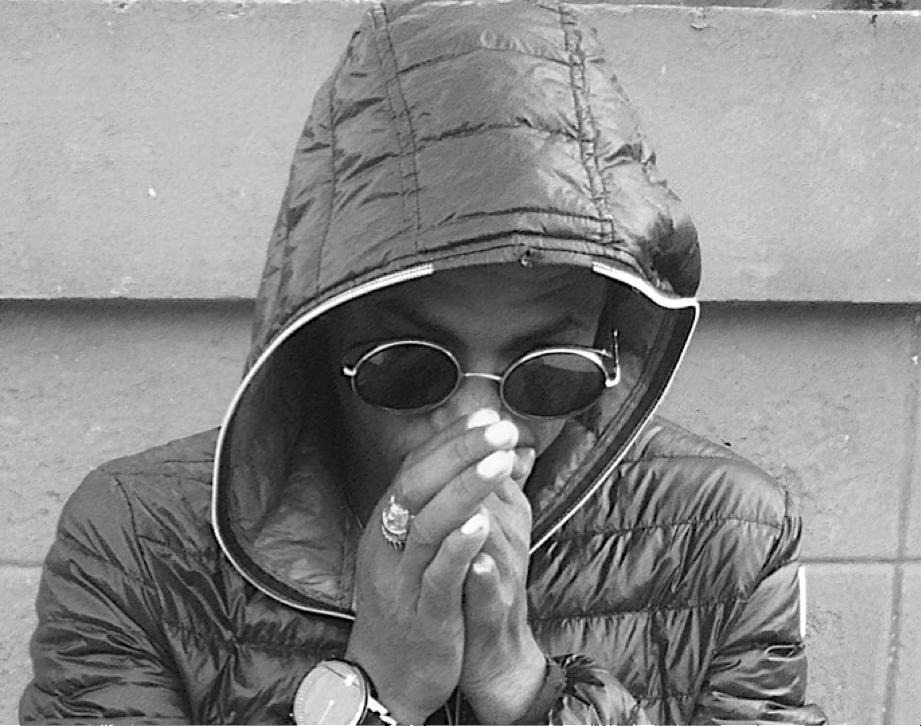
AI: What originated the protests?
Sickness and the rage of hopelessness have been the origin of these protests -as in the rest of the planet-, which highlights the absurdity of the Cuban «exceptionality» that the international left (from social democracy to post-modern Leninism) is raising, wielding all the discursive demagogy of the dictatorship, with its old story of medical excellence, the greatness of its educational system and the high «Human Development Index» (HDI). A «medical excellence» -all the oratory for external consumption-, which in reality, is far from the official quibble, with hospitals without doctors or beds and health centers (Polyclinics) lacking hygiene and running water; of course, not to mention the lack of ambulances (one for every ten patrol cars) and the constant shortage of medicines3 . This is in stark contrast to the juicy export of «human capital», through the leasing of medical brigades in «international missions» (one of the main sources of income of the economy)4 and the excellence provided in dollars by the lucrative «medical tourism» -surpassed only by sex tourism, sorry, I meant leisure tourism (second source of foreign currency of the regime) and the sending of remittances from Miami. An «educational greatness» that, in fact, is reflected in insufficient teachers and the growing desertion of young people between 15 and 16 years of age in the High School levels. An HDI that in practice, leaving aside the official figures historically made up, translates into one of the countries in Latin America with the highest suicide rate among adolescents and young people5 .
However, it should be pointed out that the underlying tone of the protests was not the demand for «solutions» to the shortage of all kinds of medicines, or the poor conditions of hospitals, or the criminal increase in the prices of basic foods, or the lack of housing and the precariousness of the buildings (while GAESA builds thousands of luxury hotels, marinas and golf courses6 ), much less, the lack of teachers; but the resounding demand for «freedom» and the unanimous cry that demanded loudly «down with the dictatorship». As a young comrade recently commented from Havana, «we do not ask the State for solutions because we know that the State is the problem» and, he adds, «we have to look for the solution in the garbage, because that is what the State is: garbage».
AI: Who participated in the protests and how were they coordinated?
As I could see in multiple videos that were transmitted live during the protests and, as confirmed by friends with whom I am in contact, the participation was varied, with people from all strata and political positions (including apolitical ones), highlighting in a significant way the intervention of young people. Particularly extensive was the presence of the poorest sectors -those excluded from the system-, where the Afro-Cuban population stands out in a preponderant way (it is not by chance that it is the majority in the prison system, in contrast with its reduced representation in the dominant elite).
As for the «coordination» of the protest, it is worth noting that it was the great absentee. There was no call whatsoever, neither in the social networks nor through the word of mouth of the Cachitas and the Cheos. It was a spontaneous explosion. So spontaneous, that it not only took by surprise the different opposition groups but also the whole framework of repression and surveillance, despite the thick alphabet soup (MININT, PNR, CDR, FMC, UJC, FEM, FEU and a long etcetera) that makes up the control system; leaving the networks of informers and the sophisticated listening system of the dictatorship in a very bad shape. The only thing that helped the extension of the protest was the dissemination of the mobilizations in real time, through digital platforms and the network of virtual links, which allowed -in a matter of minutes-, that the anti-systemic demonstration originated in the municipality of San Antonio de los Baños (31 km from the city of Havana), to be replicated almost simultaneously, This caused the Viennese cake of several floors that separates, by means of a dense jam of grievances, the multiple layers of the Cuban social cake, until reaching the top floor, where the royal family and the first circle of the privileged dwell, to wobble. However, it cannot be ignored that the success of the «surprise factor» resided in the confidence of the oligarchy in its sophisticated system of surveillance and repression and, above all, the security offered by having implanted fear and inoculated paranoia in wide sectors of society. This excess of vigilance has allowed for years the local oligarchy and its acolytes (as well as a wide range of opportunists who enjoy benefits and perks) to live as true «foreigners» in their country, which has prevented them from feeling the accumulated weariness and the rage of hopelessness. Much less have they had the capacity to foresee the coming insurrection.
AI: Has the U.S. blockade played a determining role in aggravating the causes that provoked these protests?
Before answering this question, I must emphasize the need to dismantle certain Manichaeisms -completely alien to anarchist praxis-, which inexplicably have a place in our tents and, every time the criticism of the Cuban, Venezuelan or Nicaraguan dictatorship is addressed, they resurface from the deepest recesses; as if from anarchism there were something to rescue from those States in particular. These strange libertarian postures always constrain us to take sides, deliberately forgetting that anarchists – by our very essence – do not take the side of any state (or at least, we should not). Of course, it is not the first time, nor will it be the last, that some so-called «anarchists» take sides in these state disputes and demand the cessation of sanctions by one state against another or, failing that, demand the cessation of sanctions by one state against another or, failing that, demand the cessation of sanctions by one state against another; failing that, demand the tightening of sanctions, embargoes and blockades, as was the case of those who -from anarchist positions- energetically supported the international embargo on South Africa, without paying much attention to the probable damage that the lack of oil and the subsequent paralysis of its economy would cause to the population, but with the just intention of putting an end to the apartheid imposed by the praetorian dictatorship. Something similar had already happened after the fascist coup of General Franco, with the pressures of the representatives of Spanish anarcho-syndicalism exiled in Mexico (some of them members of the so-called «government in exile») so that the Mexican State would prevent the admission of Spain to the nascent UN, since the Franco dictatorship «had been established with the military cooperation of foreign States». These pressures on the «democratic governments of the world» demanded the «isolation of Spain» (a sort of exacerbated «blockade»); a strategy which, at the beginning of the 1960s, motivated the libertarian syndicalists to visit some countries of the so-called «socialist camp», highlighting the negotiations with the former Yugoslavia and Cuba. The latter not only did not break off relations with the caudillo, but also strengthened them7 . The idyll between the two caudillos became so strong that, by orders of the (now stoned) «commander in chief», the Cuban State declared national mourning upon the death of the tyrant.
Having expressed the above, I must now clarify -giving the benefit of the doubt to some comrades- that the term «blockade», in the case that concerns us, must always be placed in the grammar of the dictatorship and the panegyric discourse of its henchmen (inside and outside the island). Of course, I hope that with this statement I will not be accused of supporting Washington’s sanctions against the Cuban State -although I must confess that, at this stage of my life, it is not an issue that keeps me awake at night-, but I consider it unacceptable to continue playing the game of the regime and not calling things by their name.
In this regard, it is worth remembering that the «imperialist blockade» is an undeniable fact of recent history, which took place during 13 days in October 1962, with the so-called «Missile Crisis», in the context of the confrontation between the two imperial powers during the «cold war» (1945-1999); when Kennedy ordered the (literal) blockade of the Cuban archipelago, creating a siege with his naval fleet and increasing the troops and planes in the south of Florida and the Guantanamo base. After the «Kennedy-Kruschev Pact» -where the agreement not to invade Cuba was settled-, the blockade was ended and the initial position was returned to; That is to say, the economic embargo imposed on February 7, 1962, which prohibited the importation of «all merchandise of Cuban origin into US territory» and which reinforced the embargo of October 19, 1960 -implemented by President Eisenhower, after the nationalization of US companies in Cuba for a value of 1 billion dollars-, which prevented US exports to Cuba, «except medicines and foodstuffs». During Bill Clinton’s administration, the Cuban Democracy Act of 1992 (also known as the Toricelli Act)8 and the Cuban Liberty and Democracy Solidarity Act of 1996 (Helms-Burton Act), extended the embargo extraterritorially, prohibiting US subsidiaries in third countries from trading with the Cuban State, which intensified political hostilities against the Castro dictatorship. To these sanctions, the government of Joe Biden recently added the freezing of accounts and assets under US jurisdiction and the prohibition of visas to travel to the United States of the director of the National Revolutionary Police (PNR), Óscar Alejandro Callejas Valcarce and Eddy Manuel Sierra Aria (deputy director of the same repressive body)9 ; within the framework of the Magnitsky Act.
After this long peroration, by way of a historical account, it only remains for me to inform -to those comrades who, out of ignorance, repeat the propaganda of the regime to the point of exhaustion-, that the United States is among the 20 main commercial partners of the Cuban State10 , being the largest supplier of «red meat, frozen turkeys and chickens, cereals, powdered milk, perishable foods, herbicides, medicines and medical supplies for humanitarian purposes (including ultrasound equipment, laboratory reagents, cannulas, prostheses, among others). «^11] Therefore, when ordinary Cubans (not the oligarchy, nor the privileged of the regime, nor the opportunists who swarm in different Cuban institutions) talk about «blockade», we invariably refer to the one implemented by the dictatorship for more than sixty years. And yes, this «internal blockade» has played a determining role in the aggravation of the causes that provoked these protests. The other, the «imperialist blockade», has been the regime’s resource par excellence to tax the precariousness of the excluded sectors and to impose surveillance and repression against any son or daughter of a neighbor, using the same label with which Hitler insulted the Jews («worms»), within the framework of the internal anathema.
1. And for the record, to qualify the Cuban dictatorship as national socialist is not to resort to any epithet, there is plenty of evidence to confirm it; only that its singularity was obtained thanks to the incorporation of the Stalinist discourse and the conjunction of both fascist practices.
2. In the year 2019, during the discussions of the preliminary draft of the Constitution, García Guerra, rightly pointed out that if the new Magna Carta was approved «sooner rather than later, we would see the riot police firing rubber bullets, hitting with water jets and beating a defenseless people with sticks».
3. In Cuba the universal right to health is «constitutionally» guaranteed; however, as Cuba’s prestige as an international reference in health care has grown, through its «medical missions», the export of drugs and vaccines «against cancer» and, «medical tourism», the internal services to the population have been deteriorating, becoming alarming the deficit of galenxs, the lack of material resources and the brutal shortage of medicines; Despite the fact that, of the 619 drugs that the Ministry of Public Health (MINSAP) labels as «basic», 359 are produced domestically through the state-owned biotechnology company BioCubaFarma; however, for some years they have been prioritizing the production of drugs for export. It is worth mentioning that in the last five years, they have allocated a much larger budget to the repressive forces.
4. It should be noted that Cuban doctors earn twice the national average salary, but their fees fluctuate between $40 and $100 dollars per month (the latter salary for specialists in «critical medicine» and «internal medicine»); however, as «volunteer cooperants» in international missions, they earn approximately US$ 950, while the Cuban State receives US$ 10 thousand dollars for each one, as a lease to the country of destination. It is worth noting that in 2018, the Cuban State received income of US$ 6, 400 million (above what was collected in the tourism sector) for the outsourcing of «professional health services» through the export of «internationalist doctors». As an additional fact, it should be emphasized that these professionals, once in the country of destination, are stripped of their passports by Cuban diplomatic authorities and subjected to a strong surveillance to prevent their desertion, evidencing a sort of modern slavery or forced labor with the consent of the contracting country.
5. According to the 48th edition of the 2019 Statistics Yearbook of the Ministry of Public Health (Minsap) of Cuba, in that year 13 people per 100 thousand inhabitants took their lives (yielding a total of 1462); less than one point of what was recorded in 2018 where 13.3 people per 100 thousand inhabitants were counted (1 501); however, according to reports from the Pan American Health Organization (PAHO) and the Regional Office of the World Health Organization (WHO), Cuba was already the country in the Americas with the highest suicide rate in 2014, occupying the ninth cause of death with respect to overall mortality and third place in the 10-19 age group (Minsap Statistical Yearbook, 2014). It should be noted that since 1969, suicide has been among the first ten causes of death in the country. In the 1980s and 1990s, the rate of deaths from self-inflicted causes exceeded previous records of 20 cases per 100 000 inhabitants. In 1982, the highest rate was reached (23.2) and, during the so-called Special Period, in 1993, 2374 people committed suicide, reaching the highest point in the last sixty years. It is worth mentioning that in 1986, the Minsap established the «National Program for the Prevention of Suicidal Behavior», with the objective of reducing mortality from this cause, without succeeding in reducing it.
6. The Armed Forces Business Administration Group (GAESA), under the «executive presidency» of General Luis Alberto Rodriguez Lopez-Calleja (former son-in-law of Raul Castro), plans to finish by 2025 in the city of Havana, 7,500 luxury rooms. According to information published during the period 2018-2019 in the official media, as recorded in the reports of the Ministry of Tourism (MINTUR) submitted to the National Assembly of People’s Power -during that same period of time-, the Gaviota Tourism Group (owned by the army, under the «executive presidency» of Major General Luis Pérez Róspide) and the real estate company Almest S.A. (also presided by General Rodríguez López-Calleja), are building 120 tourist projects in the country, with 92 thousand «five star» rooms, at a total cost of 13 billion dollars; which represents 70% of the projected investments in the Island for the year 2030. GAESA also controls the companies Tecnotex and Tecnoimport (dedicated to import and export); the only foreign currency supermarket chain; the company responsible for the Mariel Integral Development Zone (Zdimsa); the Union of Military Constructions; and the port, customs, transportation and wholesale services company (Almacenes Universales).
7. The Cuban State has maintained uninterrupted diplomatic and commercial relations with the Spanish State since 1902. At present, 300 Spanish transnationals have interests in Cuba, among them the hotel companies Meliá, Iberostar, Be Live of Globalia and Barceló; the tobacco company Altadis; the banks BBVA and Banco Sabadell; the travel promotion companies Amadeus and Viajes El Corte Inglés; and more than 40 companies with investments in the Special Development Zone Mariel (ZEDM).
8. Despite the intensification of political sanctions against the dictatorship, the Torricelli Law (named after Congressman Robert G. Torricelli, who sponsored it) authorized the export to Cuba of food, medicines and medical supplies for humanitarian purposes; without stipulating the need for payment in advance, but the verification of final use.
[9]: On the same «black list» are the Minister of the Interior (MININT), General Lázaro Alberto Álvarez Casas; the Minister of the Armed Forces (FAR), General Álvaro López Miera and; the high and middle commanders of the MININT Special Brigade (the feared «black berets»).
10. Venezuela, China, Spain, Canada, Mexico, Brazil, Russia, Italy, Germany, France, Vietnam, Algeria, Argentina, Holland, the United States, Belgium, South Korea, Portugal, India and Colombia are among the main trading partners of the Cuban State, out of a list of 70 countries with which the dictatorship maintains the largest exchange of goods and services. According to the latest figures published (not updated) by the official National Office of Statistics and Information (ONEI), only in 2018, China held a commercial exchange for 2 billion 990 thousand; while with Spain the amount reached 1.39 billion 260 thousand pesos. In that same year, Cuba exported goods for 2 billion 372 million 779 thousand pesos and imported a total of 11 billion 483 million 653 thousand pesos; yielding a trade deficit of 9 billion 110 million 874 thousand pesos that was compensated with tourism activity and the export of services in the health branch. (information available in the Statistical Yearbook of Cuba 2018 /Edition 2019).
11. Between 2001 and 2020, the total value of U.S. exports to Cuba in agricultural products, food, medicines and medical supplies amounted to $ US 6 308 778 608, according to data from the Economic Complexity Observatory. By 2018, the United States ranked eighth in origin of imports with a total of 4.04 %; while Cuba ranked 60th (out of 226) of the U.S. food and agricultural exports markets, says a report published by the United States-Cuba Economic and Trade Council.
